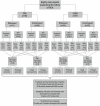Rewarming From Hypothermic Cardiac Arrest Applying Extracorporeal Life Support: A Systematic Review and Meta-Analysis
- PMID: 34055829
- PMCID: PMC8155640
- DOI: 10.3389/fmed.2021.641633
Rewarming From Hypothermic Cardiac Arrest Applying Extracorporeal Life Support: A Systematic Review and Meta-Analysis
Abstract
Introduction: This systematic review and meta-analysis aims at comparing outcomes of rewarming after accidental hypothermic cardiac arrest (HCA) with cardiopulmonary bypass (CPB) or/and extracorporeal membrane oxygenation (ECMO). Material and Methods: Literature searches were limited to references with an abstract in English, French or German. Additionally, we searched reference lists of included papers. Primary outcome was survival to hospital discharge. We assessed neurological outcome, differences in relative risks (RR) of surviving, as related to the applied rewarming technique, sex, asphyxia, and witnessed or unwitnessed HCA. We calculated hypothermia outcome prediction probability score after extracorporeal life support (HOPE) in patients in whom we found individual data. P < 0.05 considered significant. Results: Twenty-three case observation studies comprising 464 patients were included in a meta-analysis comparing outcomes of rewarming with CPB or/and ECMO. One-hundred-and-seventy-two patients (37%) survived to hospital discharge, 76 of 245 (31%) after CPB and 96 of 219 (44 %) after ECMO; 87 and 75%, respectively, had good neurological outcomes. Overall chance of surviving was 41% higher (P = 0.005) with ECMO as compared with CPB. A man and a woman had 46% (P = 0.043) and 31% (P = 0.115) higher chance, respectively, of surviving with ECMO as compared with CPB. Avalanche victims had the lowest chance of surviving, followed by drowning and people losing consciousness in cold environments. Assessed by logistic regression, asphyxia, unwitnessed HCA, male sex, high initial body temperature, low pH and high serum potassium (s-K+) levels were associated with reduced chance of surviving. In patients displaying individual data, overall mean predictive surviving probability (HOPE score; n = 134) was 33.9 ± 33.6% with no significant difference between ECMO and CPB-treated patients. We also surveyed 80 case reports with 96 victims of HCA, who underwent resuscitation with CPB or ECMO, without including them in the meta-analysis. Conclusions: The chance of surviving was significantly higher after rewarming with ECMO, as compared to CPB, and in patients with witnessed compared to unwitnessed HCA. Avalanche victims had the lowest probability of surviving. Male sex, high initial body temperature, low pH, and high s-K+ were factors associated with low surviving chances.
Keywords: cardiac arrest; cardiopulmonary bypass; extracorporeal life support; extracorporeal membrane oxygenation; hypothermia; hypothermic cardiac arrest; resuscitation; rewarming.
Copyright © 2021 Bjertnæs, Hindberg, Næsheim, Suborov, Reierth, Kirov, Lebedinskii and Tveita.
Conflict of interest statement
The authors declare that the research was conducted in the absence of any commercial or financial relationships that could be construed as a potential conflict of interest.
Figures





Similar articles
-
Is extracorporeal rewarming indicated in avalanche victims with unwitnessed hypothermic cardiorespiratory arrest?High Alt Med Biol. 2014 Dec;15(4):500-3. doi: 10.1089/ham.2014.1066. High Alt Med Biol. 2014. PMID: 25531463 Review.
-
Hypothermia outcome prediction after extracorporeal life support for hypothermic cardiac arrest patients: The HOPE score.Resuscitation. 2018 May;126:58-64. doi: 10.1016/j.resuscitation.2018.02.026. Epub 2018 Mar 2. Resuscitation. 2018. PMID: 29481910 Review.
-
Cooling to Hypothermic Circulatory Arrest by Immersion vs. Cardiopulmonary Bypass (CPB): Worse Outcome After Rewarming in Immersion Cooled Pigs.Front Physiol. 2022 Mar 31;13:862729. doi: 10.3389/fphys.2022.862729. eCollection 2022. Front Physiol. 2022. PMID: 35431978 Free PMC article.
-
Hypothermia outcome prediction after extracorporeal life support for hypothermic cardiac arrest patients: An external validation of the HOPE score.Resuscitation. 2019 Jun;139:321-328. doi: 10.1016/j.resuscitation.2019.03.017. Epub 2019 Mar 30. Resuscitation. 2019. PMID: 30940473
-
Prediction and risk stratification of survival in accidental hypothermia requiring extracorporeal life support: An individual patient data meta-analysis.Resuscitation. 2018 Jun;127:51-57. doi: 10.1016/j.resuscitation.2018.03.028. Epub 2018 Mar 23. Resuscitation. 2018. PMID: 29580960
Cited by
-
Mortality Predictors and Neurological Outcomes Following Extracorporeal Cardiopulmonary Resuscitation (eCPR): A Single-Center Retrospective Study.J Cardiovasc Dev Dis. 2024 Sep 2;11(9):272. doi: 10.3390/jcdd11090272. J Cardiovasc Dev Dis. 2024. PMID: 39330330 Free PMC article.
-
Hypothermic cardiac arrest patients admitted to hospital who were not rewarmed with extracorporeal life support: A retrospective study.Resusc Plus. 2023 Aug 10;15:100443. doi: 10.1016/j.resplu.2023.100443. eCollection 2023 Sep. Resusc Plus. 2023. PMID: 37638095 Free PMC article.
-
The Beginning of an ECLS Center: First Successful ECPR in an Emergency Department in Romania-Case-Based Review.J Clin Med. 2023 Jul 26;12(15):4922. doi: 10.3390/jcm12154922. J Clin Med. 2023. PMID: 37568324 Free PMC article. Review.
-
Extracorporeal Life Support for Recurrent Hypothermic Cardiac Arrest: A Case Report.Cureus. 2023 Nov 29;15(11):e49684. doi: 10.7759/cureus.49684. eCollection 2023 Nov. Cureus. 2023. PMID: 38161851 Free PMC article.
-
Accidental Hypothermia: 2021 Update.Int J Environ Res Public Health. 2022 Jan 3;19(1):501. doi: 10.3390/ijerph19010501. Int J Environ Res Public Health. 2022. PMID: 35010760 Free PMC article. Review.
References
-
- Morita S, Inokuchi S, Yamagiwa T, Iizuka S, Yamamoto R, Aoki H, et al. . Efficacy of portable and percutaneous cardiopulmonary bypass rewarming versus that of conventional internal rewarming for patients with accidental deep hypothermia. Crit Care Med. (2011) 39:1064–8. 10.1097/CCM.0b013e31820edd04 - DOI - PubMed
Publication types
LinkOut - more resources
Full Text Sources
Other Literature Sources

